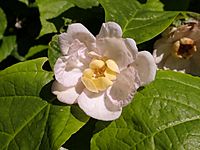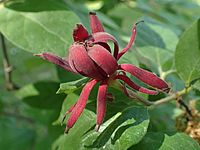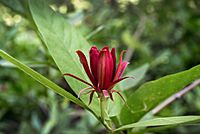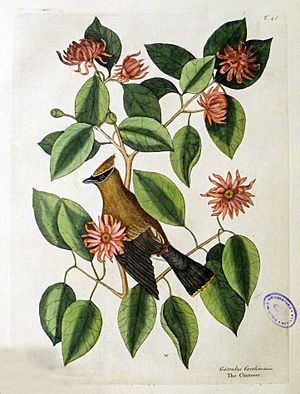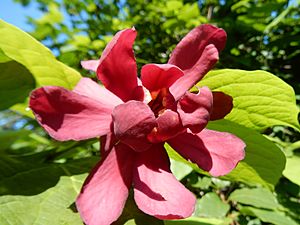Calycanthus facts for kids
Quick facts for kids Calycanthus |
|
|---|---|
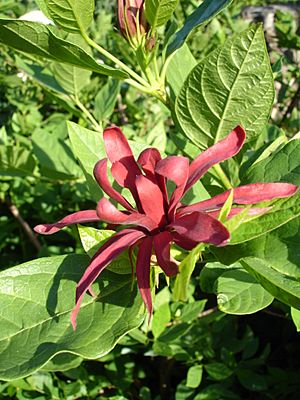 |
|
| Calycanthus floridus | |
| Scientific classification |
|
| Kingdom: | Plantae |
| Clade: | Tracheophytes |
| Clade: | Angiosperms |
| Clade: | Magnoliids |
| Order: | Laurales |
| Family: | Calycanthaceae |
| Genus: | Calycanthus L. |
| Species | |
| Synonyms | |
|
List
|
|
Calycanthus, also known as sweetshrub, is a group of flowering plants found only in North America. These plants belong to the Calycanthaceae family. Most experts agree there are three main types, or species, of sweetshrub.
Contents
Description
Sweetshrub plants are deciduous shrubs, meaning they lose their leaves in the fall. They can grow up to 4 meters (about 13 feet) tall. Their leaves grow opposite each other on the stem and are not divided into smaller parts. These plants are known for their pleasant smell.
Their flowers are special because they don't have separate sepals and petals. Instead, they have many spirals of tepals, which are like a mix of sepals and petals. Flowers appear from spring and can last until October for some types. The flowers of the two North American sweetshrubs smell nice and are about 4 to 7 centimeters (1.5 to 2.7 inches) wide. They have many dark red, burgundy, or purplish-brown tepals. The Chinese sweetshrub, C. chinensis, has wider tepals. Its outer tepals are white with a pink blush, and the inner ones are mostly yellow with purple spots.
After flowering, the plant produces a dry, oval-shaped capsule (a type of fruit). This capsule holds many seeds.
Pollination
C. floridus and C. occidentalis are pollinated by beetles. Their flowers make small, protein-rich growths that feed these beetle pollinators. C. occidentalis even produces chemicals that smell like fermenting fruits. This smell attracts beetles from certain families, like the Nitidulidae and Staphylinidae.
Taxonomy
The group Calycanthus was first named by Carl Linnaeus in 1759. At that time, it only included the species Calycanthus floridus. Later, in 1762, he added another plant, Calycanthus praecox, which is now known as Chimonanthus praecox.
Plant Family Tree
Scientists use molecular phylogenetic studies to understand how plants are related. A study in 2006 looked at the DNA of the Calycanthaceae family. It found that the three main Calycanthus species are closely related and form a single group.
The Calycanthaceae family might have first appeared in an ancient supercontinent called Gondwana. The only Australian plant in this family, Idiospermum australiense, is like a living fossil from the Cretaceous period. Even though there are no living members of this family in South America today, fossils show they once lived there. Calycanthus might have traveled to North America from eastern Asia, or it might have started in South America and then spread north and to eastern Asia.
Species
As of February 2020, the Plants of the World Online database recognizes four species of Calycanthus:
- Calycanthus brockianus—Found in north-central Georgia. It has greenish flowers instead of reddish-brown ones. Some think it might just be a different color version of C. floridus.
- Calycanthus chinensis (also called Chinese sweetshrub or Chinese wax shrub)—Native to eastern China. It has white flowers.
- Calycanthus floridus (also called Carolina spicebush or eastern sweetshrub)—Native to the Eastern United States. It grows from New York and Missouri, south through the Appalachian Mountains, Piedmont, and Mississippi Valley, to Louisiana, and east to northern Florida.
- C. f. var. floridus (eastern sweetshrub)—Its twigs are hairy.
- C. f. var. glaucus (eastern sweetshrub)—Its twigs are smooth.
- Calycanthus occidentalis (also called California spicebush or western sweetshrub)—Native to wet areas of California below 1,500 meters (about 4,900 feet). This includes the California Coast Ranges, San Joaquin Valley, and Sierra Nevada. As of February 2021, two plants were found in Oregon, but it's unclear if they are native there.
The history of naming C. chinensis has been a bit confusing. It was first described in 1963, but the description wasn't fully correct. The authors then correctly described it in 1964 under a new group name, Sinocalycanthus. However, in 1979, another botanist decided that Sinocalycanthus was not a separate group and confirmed the original name Calycanthus chinensis.
Cultivation
Calycanthus species are grown as ornamental plants by plant nurseries in places like the United States and England. People plant them because they are beautiful.
Calycanthus floridus is often planted in gardens as a single shrub or to make hedges. An English naturalist named Mark Catesby drew this plant in his book, which was published starting in 1731. He drew it as a perch for a bird he called "The Chatterer" (now known as the Cedar waxwing). Catesby described the shrub as growing in "remote and hilly parts" and having bark that smelled "as odoriferous as cinnamon." Early settlers in the Carolinas moved these plants into their gardens. A botanist named Peter Collinson told Linnaeus about it and brought it to England from Charleston around 1756.
Calycanthus occidentalis is planted in many types of gardens, including traditional, native plant, and wildlife gardens. It's also used for natural landscaping and projects that restore natural habitats, especially in California and the Western United States. This plant was first grown in gardens in 1831.
Calycanthus chinensis was brought to gardens in the United States and the United Kingdom from the Shanghai Botanical Garden in the 1980s. Since then, it has been widely used to create new plant varieties called cultivars.
Hybridization
Scientists have created several hybrids and hybrid cultivars. These are new plants made by crossing different species. The goal is to combine the larger flower size of C. chinensis with the color and scent of the two North American species, and to make them tougher against cold weather.
One hybrid, made by crossing C. chinensis and C. floridus, is called C. × raulstonii. It has the large flowers of C. chinensis and the flower color of C. floridus. The first plant from this cross was named 'Hartlage Wine' after the student who created it. Other crosses have been made too. For example, 'Venus' includes C. occidentalis in its family tree.
Some popular hybrid cultivars include:
- 'Aphrodite' (C. chinensis × C. occidentalis) – This plant from the US has large reddish-purple flowers with yellow spots inside. Its flowers grow on long stalks and bloom for a long time.
- 'Hartlage Wine' (C. × raulstonii) – Created in the US in 1991. It looks like C. chinensis in leaf and flower size, but has the flower color of C. floridus. It can grow up to 2 meters (about 6.5 feet) tall. It has received an award from the Royal Horticultural Society.
- 'Hongyun' (C. × raulstonii) – From China, 2001. It has the large flowers of C. chinensis and the red color of C. floridus.
- 'Solar Flare' (C. × raulstonii) – From the US, 2003–2006. It is similar to 'Hartlage Wine' but has larger, thicker leaves and smaller flowers. It seems to be more resistant to frost than 'Hartlage Wine'.
- 'Venus' (C. × raulstonii × [C. chinensis × C. occidentalis]) – This plant has large white flowers with yellow and purple marks in the center. It also has a strong fragrance.
Other uses
Both Calycanthus floridus and C. occidentalis were used as traditional medicinal plants by Native Americans. The indigenous peoples of California also used C. occidentalis for making baskets and for arrow shafts.
Essential Oils
Calycanthus oil is an essential oil made by distilling the flowers. This oil is used in some high-quality perfumes because of its unique scent.
See also
 In Spanish: Calycanthus para niños
In Spanish: Calycanthus para niños


